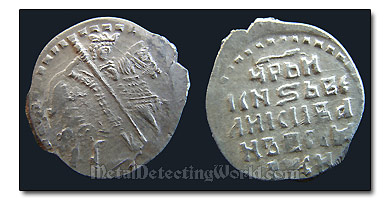Method for Minting Wire Coins
Simple Technique for Coining Wire Money Remained Unchanged for Over 350 Years

The Early Russian silver hammered coins are often referred to as "Wire Money" due to an unusual method of their production. The wire coins are also called "Fish Scales" - Cheshuiki - "чешуйки" in Russian, for their shape and thinness.
The wire money were produced from the silver wire which was made from the silver Thalers brought to Russia from the European kingdoms. The minting process would begin with melting of the silver received by the mint for special hot cleaning (all the Early-Russian silver coins of the 16th - beginning of the 17th centuries, until 1626, had the "960" milessimal fineness).
Then the silver bars were processed into wire of the needed diameter. The wire was cut into measured lengths which were flattened and annealed to gain their plasticity. The resulting blanks (flans) were struck between two dies with a hammer. During the hammering the dies were not conjugated: the lower die was fixed in a special support, the upper die was held in the hand of the striker (hammerer), who directed it on the blank laying on the lower die.
Such crude hammering resulted in coins of a slightly elongated shape, often showing traces of the original wire from which they had been made. From the beginning of the 15th century, the dies were not engraved by hand, but imprinted to the red-hot iron with super strong counter-dies with engraved image or inscription. Invention and use of the counter-dies allowed to produce a series of identical dies.
Because of the imperfect techniques of coining the wire money by hand, the coins might bear many defects on the obverse and reverse designs: the horse might be without one or two legs, the spear or the horsemanís cloak might be partially missing, one or more letters in the inscription might be absent, a few letters can be reversed and so on. Hammering the coins with the worn-out die produced unclear lines in images - some details were lost. Cracks and bumps in the field of the rusted die made the images grainy and dull. Uneven distribution of the strength during the dieís strike made the letters of script appear clear-cut on one edge of the coin and only weak on another (to learn about minting defects on wire coins, please see my illustrated tutorial - "Grading Wire Coins" (coming up soon)). All things mentioned can make identification of wire coins very complicated or sometimes impossible (see my Illustrated Tutorial on Identification of Wire Money, ca. 1462-1717 (coming up soon)).
The coining of silver hammered dengas decreased after the 16th century but they are known up until the reign of Peter the Great. In 1704, Russia was the first country in the world to introduce a decimal monetary system, where one ruble was equal to 100 kopecks or 200 dengas.
By that time, continuous debasement of the coinage had proceeded to such an extent that dengas weighed only about 0.14 grams, and were of little practical use. The production of Russian wire money stopped at all state mints in January of 1718.
The coining of silver hammered dengas decreased after the 16th century, as they are found less frequently in coin hoards, but they are known up until the reign of Peter the Great. In 1704, Russia was the first country in the world to introduce a decimal monetary system, where one ruble was equal to 100 kopecks or 200 dengas.
By that time, the devaluation of the coinage had proceeded to such an extent that dengas weighed only about 0.14 grams, and were of little practical use. The production of Russian wire money stopped at all state mints in January of 1718.
You might want to check out my Photo Gallery of Russian Medieval Hammered Coins - Wire Money for detailed descriptions of the wire coins' obverses and reverses, and to see the exact cyrillic letters inscribed in the coin legends.
Back to Detect Hammered Coins Index page